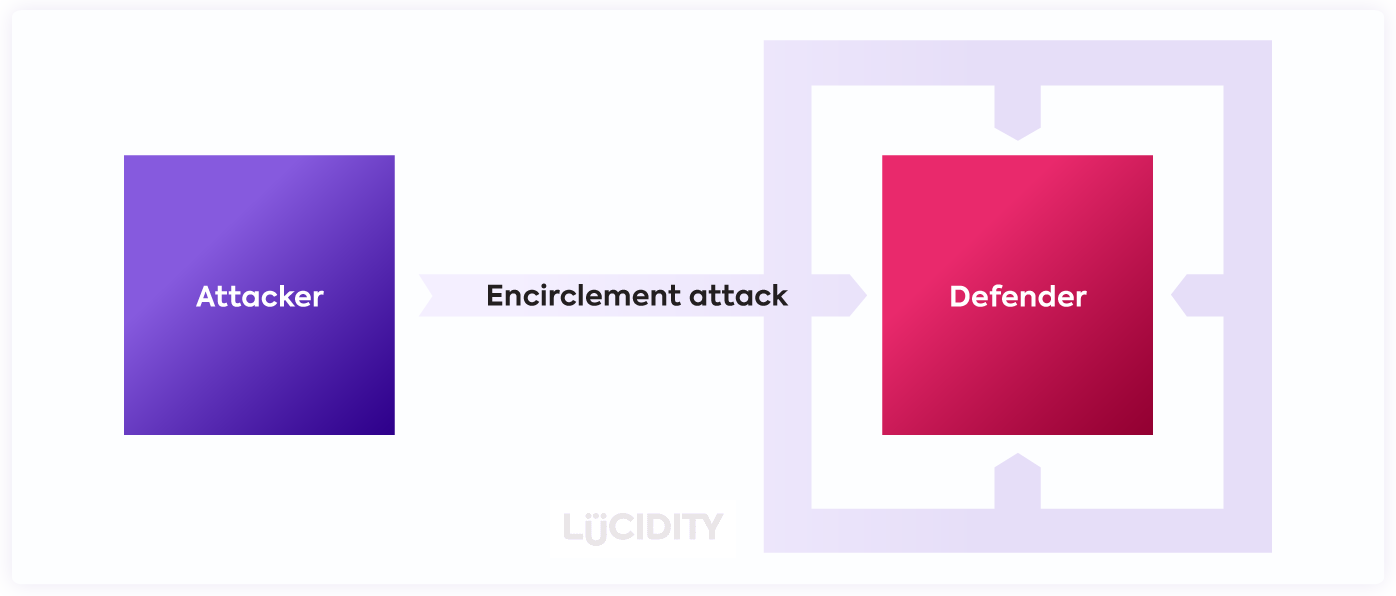When you’re entering a market there are many approaches you can take, varying strategic positions you can adopt, and likely numerous competitors you’ll need to take down.
The Encirclement Attack Strategy is an aggressive approach to attacking an existing player in a market. Let’s take a look in more detail…
What is an Encirclement Attack Strategy?
An Encirclement Attack Strategy is where you attack a competitor on several fronts at the same time in order to disrupt them and take market share. The theory being, that the defender will not be able to successfully defend all parts under attack, and will be disorientated and confused by the approach.
As the above suggests, this attack strategy means you’ll be focusing on both the competitors strengths and their weaknesses at the same time. If they have multiple products, services, or are in different geographies, then you’ll be taking on lots of those at the same time.
It doesn’t mean you need to attack all areas at once, but certainly a significant number in order to be successful. It’s a difficult strategy to pull off because it requires hefty investment, planning and resources from the attacking company.
The implementation of Encirclement Attack can come in a few different forms. You may launch multiple products at the same time, even within the same market, or you could go down the route of having the same product but offering different levels of service or geographies.
What tools or frameworks help when devising an Encirclement Attack Strategy?
Like all Attack Strategies, Encirclement requires a highly detailed understanding of the competitor. It is therefore crucial that you undertake some thorough competitor analysis before finalising your Encirclement approach. We would recommend that you do the following:
- Run a Four Corner Analysis on your competitor
- Understand their BCG Matrix
- Conduct an industry analysis to be prepared for what is coming
Undertaking that analysis will ensure you have a solid grasp of your target competitor’s ambitions and objectives, their current strategy and activities, their brand perception, their strengths and weaknesses and the profile and importance of their products or services. Combining that with an understanding of the structure, risks, opportunities and future impacts of the market will give you a firm foundation for making the right strategic decisions when it comes to planning your Encirclement Attack Strategy.
What are the benefits of an Encirclement Attack Strategy?
When weighing up whether the Encirclement Attack Strategy is right for you, you need to consider the pros and cons. On the positive side, there are a couple of pros with Encirclement.
Firstly, when attacking your competitor across multiple attack points you are increasing your chances of success. In other words, by simultaneously launching a number of different efforts you are hedging your bets and creating more opportunities to win.
Secondly, this many pronged attack can prove extremely difficult for the defender to keep up with. Successfully defending against an Encirclement Attack requires a coordinated response and action from multiple areas of the business. Recognizing an Encirclement Attack can be challenging and often requires a level of internal cohehsion that businesses rarely have. The often siloed departments and teams need to come together to facilitate an effective, joined-up defence strategy. That is not easy.
What are the cons of an Encirclement Attack Strategy?
The Encirclement Attack Strategy is by no means an easy way to take on a competitor as it involves efforts on every single front. The cons of this approach include:
- It’s expensive and resource intensive and therefore usually requires the attacking business to be considerably stronger than the defender if it stands a chance of being successful
- The defending company has a natural advantage being the current and established market leader
- It requires you to focus on more than one product or service at a time
- If it goes wrong you end up retreating on all fronts
What are some examples of an Encirclement Attack Strategy?
The most often cited example of Encirclement Attack Strategy is the e-commerce world, where competitors are attacking each other on all fronts across large inventories of products. Here you see challengers take on established market leaders by matching them product for product, even going so far as losing margin or selling products at a loss to achieve market share.
What are the alternatives to an Encirclement Attack Strategy?
The Encirclement Attack Strategy is one of a number of Attack Strategies. If you’re looking for a market challenger approach to use, consider each of these to help inform your strategy and make the best decision:
Frontal Attack Strategy
Attack the competitor head on, matching their strengths and opportunities. This is a pretty difficult strategy to pull off as you’re taking on someone who is very strong in their own market, often with greater resources and reputation than you have.
Flanking Attack Strategy
Attack the competitor based on their weaknesses. This one is often used for niche products or services – think how FantastiCal has grown against Outlook or Gmail. It took one specific area of these popular products (the calendar), arguably one that wasn’t the sole focus, and targeted it.
Bypass Attack Strategy
Attack the competitor by going round their core product, often creating a direct substitution. In this strategy a company will create a true alternative for the defender’s customers. Spotify developed a streaming music service that forced Apple iTunes, a business that sold music files, to rethink and relaunch as streaming music to combat. This can be a very effective way to dislodge a market leader and disrupt the landscape, so much so that the strategic framework Porter’s Five Forces lists ‘threat of substitution’ as one of the most important considerations for a business.
Guerrilla Attack Strategy
With the Guerrilla Attack Strategy the attacker is developing a collection of small, targeted campaigns to chip away at the competition. The attacker is normally a smaller, more agile company running specific campaigns at the larger incumbent. It’s a reasonably common approach by companies when entering a market, with it’s own set of risks around effectiveness and focus.
Good luck planning your strategy and mounting your attack! We wish you every success (assuming you’re not a competitior of ours 😬).
Let’s build your battle plan!
Book a demo and we'll show you how easy it is to build your competitive strategy in Lucidity and win.












